Scales and Major Blues
If you regularly visit guitar forums and social media posts, information on scales to use over major blues chord progressions often ends up confusing and, quite frankly, is often wrong. That’s not to say the subject isn’t slightly complicated but that comes more from trying to relate things to traditional music theory – blues generally breaks a few of the so-called rules.
To really get to grips with this style of music you need to just learn and practise the style, learn licks, phrases, riffs etc, spend a lot of time working on string bending, expression, and listening to other blues guitarists to build ideas from. Practise until you have enough to piece things together in your own way. Other than the minor pentatonic and blues scale, if you think of things in terms of alternate scale patterns then it’s bound to lead to frustration.
There’s basically two ways to solo over major blues as far as scales go. One is to use the minor pentatonic / blues scale. It creates a minor / major clash but it’s what we’re used to hearing in this style and you can go a long way just using this scale. The other is to use the major or Mixolydian scale, but this is where things are mostly misunderstood. We’ll get to this in a little while, but before we do, let’s think about the chords before we move on.
Most blues will be based on the I-IV-V chord progression. Like the minor blues, there are variations but we’re not going to overcomplicate things here, there’s no need. Some blues can get more involved, look at the chord progression in “Stormy Monday” for instance (just look it up if you don’t know it), you need to get to grips with the basic I-IV-V first. Remember, most of these old bluesers neither knew or cared about theory, they just built their repertoire by listening to others, trying to imitate them and messing around with what they learned from that. Don’t try to over-theorise everything, if a song goes against the grain, then just learn the song and move on. You’ll eventually find there’s a lot of commonality between them.
Okay, back to the chords. We have the I-IV-V, we’re in the key of C major so the obvious choice of chords are C, F and G. We don’t often strum the full chord – it sort of works but doesn’t sound very bluesy, even in an up tempo blues they’re a bit too clinical sounding. Because of this, most major blues rhythms will be based on partial chords, blues riffs, fifths and / or dominant chords. First let’s look at the common blues riff, the one we all know.
Example 40
The common blues riff
Example 41
Here’s a common variation.
The thing these two riffs have in common is neither of them contain a 3rd in the chords. This makes them neutral, they are neither minor nor major chord progressions. We could just say they are open to interpretation. If we play a C major scale over them, then the chords will take on a major sound. If we play a C minor scale, they’ll take on a minor sound. Same thing happens with the pentatonics. With that said, however, if we play these particular blues riffs over minor chords, they don’t usually sound too good, even though they don’t contain any thirds, they tend to have a major feel about them.
It’s not always worth trying to over analyse these things. Blues is a sound we are used to hearing and played in common ways – it’s probably for that reason we think things sound OK.
There are other fairly common riffs used in blues but generally speaking, the I-V-V in major blues chords progressions are usually riff based or played using all dominant chords – for example, C7, F7, G7. I’ll say it one more time “Generally speaking” – of course you will come across variations that prove the opposite, but if you think of a major blues as all dominant 7th chords, whether riff based or not, then you shouldn’t go too wrong.
Example 42
Blues chord progression using dominant 7th chords
When it comes to scales to use for soloing, this is where things can get confusing. Most of it comes from a lack of understanding and bad information. Let’s start with one option … use the minor pentatonic over the whole thing. Just to clarify, whether using the riffs above, or all 7th chords, just use C minor pentatonic over the lot. It’s technically wrong in terms of traditional music theory, it creates a minor / major clash, but it works. We’re used to the sound, and a lot of musicians do it. It’s also a nice easy option.
All other options using major scales or, dare I say it, Mixolydian over each chord, things start to get a bit tricky. I shall attempt to explain things but, to begin with, I’ll just say this – when we solo over a major blues using anything other than the minor pentatonic, it’s probably best to forget all about scales – or to be more precise, “scale patterns”. Regardless of whatever you read in forums and social media, if you just grab a major scale or Mixolydian and arbitrarily play around with the scale notes, you are doomed to fail. It doesn’t work. With major blues, things need to be more targeted, much like explained in part one of this series – just because you have a bunch notes in a scale, it doesn’t mean they all function the same over each chord.
Here are the most common scale approaches you will hear others talk about for soloing over major blues.
1: Use the minor pentatonic
2: Use the major scale
3: Use the major pentatonic
4: Use Mixolydian over each chord.
5: Use the major pentatonic over the I chord and minor over IV and V
6: Use a mix of major and minor.
Here’s what I think about them.
1: Use minor pentatonic? Yes, absolutely.
2: Use the major scale? Absolutely not.
3: Use major pentatonic? Yeah, kind of, maybe
4: Use Mixolydian modes over each chord? Worst advice ever.
5: Major pentatonic over I chord, minor pentatonic over IV and V? Yes, to an extent.
6: Use a mix of major and minor pentatonic? Yes, absolutely, but carefully.
And now the one that we get told the least often.
7: Just learn licks, phrases and blues soloing concepts? Absolutely totally yes without any doubt.
Before I delve into my reasoning, again a quick disclaimer before I come under attack from the blues police. Yes, all of the above can work to some extent, more so with funky, rock, blues fusion etc. The problem is this stuff can be quite advanced and requires a lot of experience. It should not be taught to anyone asking the question, “what scales should I use”. The question itself implies a lack of experience. If you are indeed lacking this experience then you will likely think of a scale as a pattern of notes to be played around with arbitrarily. If you want to sound anything like the so-called blues greats, then learn to think and play more like they do, which mostly includes none of the above scale ideas.
The minor pentatonic, over blues, is just about the only scale you can almost get away with “just playing scale notes”. Not completely, but it is very forgiving.
For major blues you could do the same, but using the major pentatonic. Although it kind of works, it’s not so forgiving as the minor pentatonic, probably because we’re so used to the minor pentatonic that habits take over, especially of you use the “move down three frets” approach, i.e., use Am pentatonic over C major.
Then there’s the full major scale. Good luck with that, I guarantee it will sound like crap.
What about using Mixolydian over each chord? In other words, use C Mixolydian over the C7 chord, F Mixolydian over the F7 chord and G Mixolydian over the G chord? I guarantee that will sound even worse than sticking with the C major scale.
Again, disclaimer. The above is what happens when you think in terms of scale patterns. If you do, then your soloing will sound like scales – and I guarantee those scales will all sound like crap over a blues chord progressions.
Right, let’s get to an example. We’ll say the chords are C7, F7 and G7 and we are going to play Mixolydian over each chord. We’ll keep it simple but try to cram every note of the Mixolydian mode over each chord change. We’ll use a small C Mixolydian scale (mode) around the 8th fret and then move it along to the 13th and 15th fret for the F and G chords.
Example 43
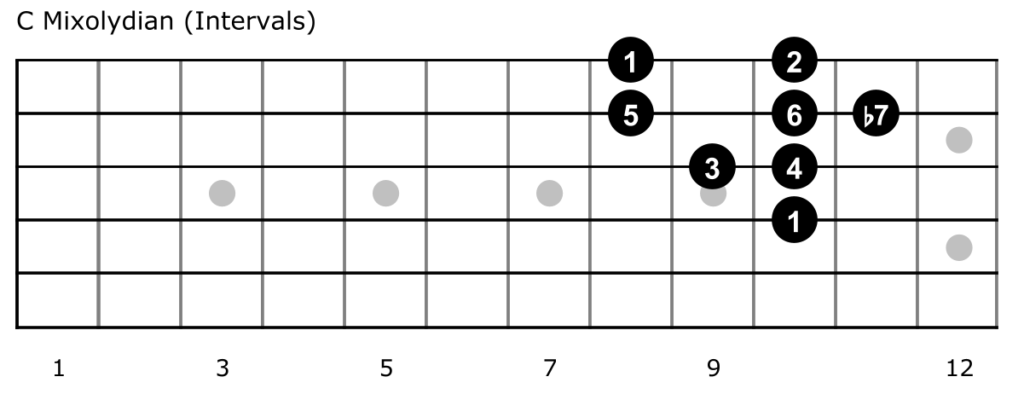
What do you think? I think it works OK but it’s a bit boring and not particularly bluesy. Obviously we could come up with hundreds of variations that might sound better, I doubt that much better though, especially if we try to cram in all the Mixolydian notes over each chord. Maybe we could slow it down a bit, use fewer notes perhaps? Yes, that would be a good start but then we have to listen and pick our notes more carefully – just like everything else we’ve looked at so far, not all scale notes work well all of the time if you hang on them for too long.
If we do our test of listening to each note one at a time against the chords then we find that some don’t work very well. I’m not going to show examples of this, if you’ve read this full series then you should know by now how to do that. We’ll find some notes work, some don’t, some work over one chord but not another, etc.
What I will do is give you some things to think about. First, and most importantly – the Mixolydian, or any scale for that matter, only belongs to one single key. If we therefore use C, F and G Mixolydian over the same chord progression, then to some extent we are implying a key change over each chord. This, however, is not what’s happening. Even though each dominant chord only belongs to one key, the overall tonal centre in a I IV V is that of the I chord, whether they are all major triads or all dominant 7ths won’t change that. Nowhere are we modulating to a different key.
The intervals of the Mixolydian mode are 1, 2, 3, 4, 5, 6, b7. If you do the listening test over each chord you might come to the conclusion that two of the worst sounding notes are the 2 and 4. If we take them out and play 1, 3, 5, 6, b7 over each chord, what happens? Take a listen, you’ll certainly recognise it.
Example 44
We can of course make some use of the 2 and 4. We could put them back into the scale and use them as passing notes or just take more care with where we use them. If that’s the case then what am I going on about? surely that makes it Mixolydian again and debunks my own argument, doesn’t it?
That depends how you want to look at it. Here’s another example to think about.
Example 45
In this lick I’m using the notes 1, b3, 3, 4, b5, 5, 6, b7, 7. I could use these notes quite a lot, I could move them along to the F and G chords, make it a part of my playing style and then people on forums would argue I’m using the chromatic scale. It’s just nonsense and unnecessarily confuses things.
The bottom line here is that when we think of soloing everything in terms of scales or modes, then we will end up thinking about things all wrong. If you really want a scale to use for each chord in a dominant blues progression then try using the cut down Mixolydian as used in the blues riff, it’s just five notes. 1, 3, 5, 6, b7 and can be moved around. It implies the dominant 7 for each chord and it’s what many people mistakenly call Mixolydian.
Use this simple idea to kick off with and use as a building block for experimenting with major blues. Get used to it and try to combine it with the minor pentatonic. This will get you much closer to the dominant blues sound and will sound much better than the urban “Mixolydian” myth.
Example 46
I will eventually do an article or add some practising ideas for blues on the website. In the meantime, listen to others, learn riffs and licks, experiment and play around with them. Adapt them to fit different styles. You just need to learn to use notes carefully and this will come naturally to you when you learn a whole bunch of licks that do work. You could also check out my course on Soundslice which covers a lot of this stuff.
Check it out here: Pentatonic Workshop at Soundslice
That’s all for now folks. Maybe we’ll tackle the dreaded modes in my next ramblings, comment below for questions.

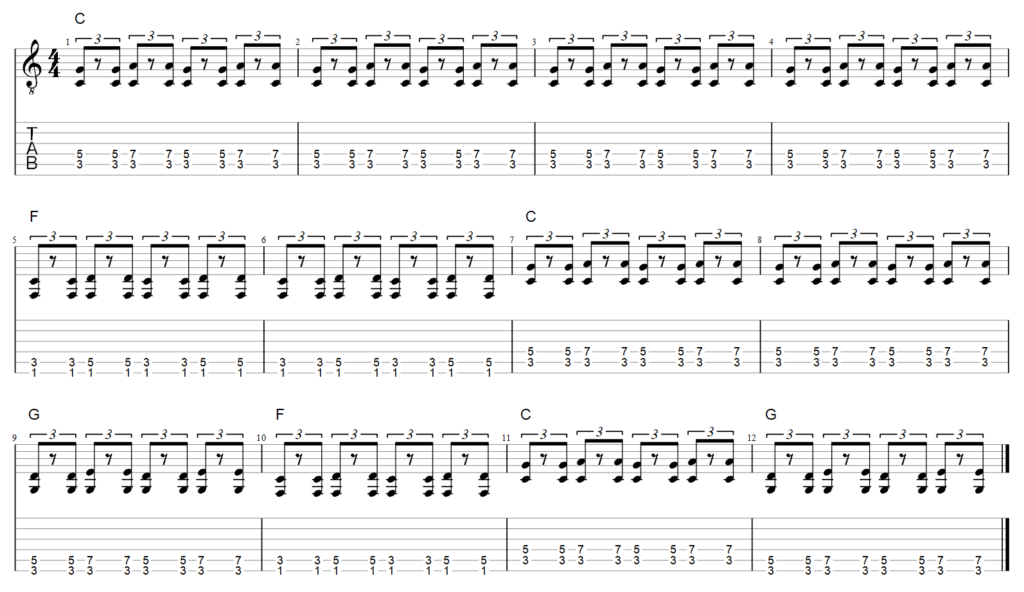
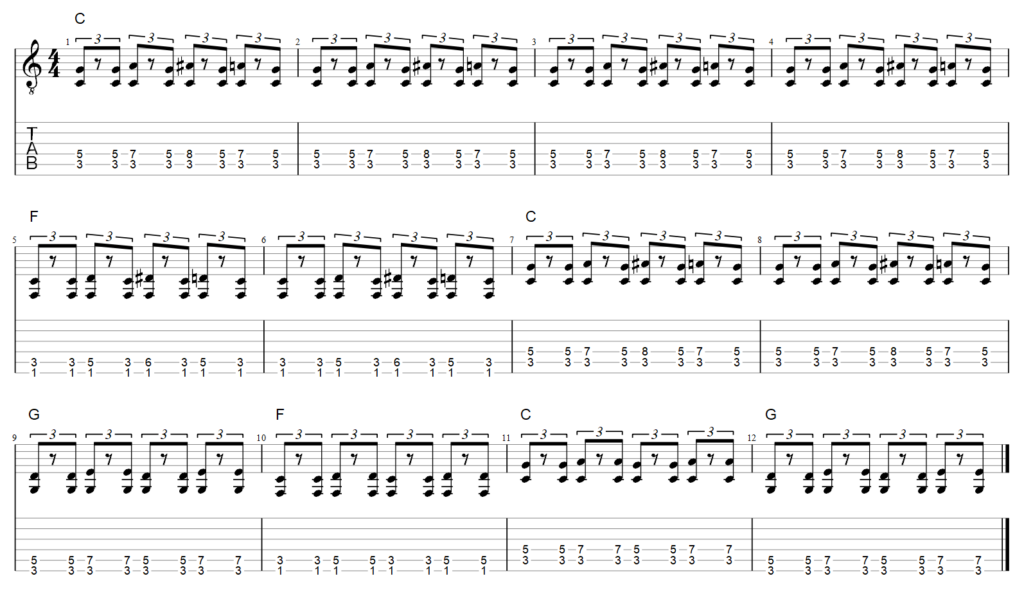
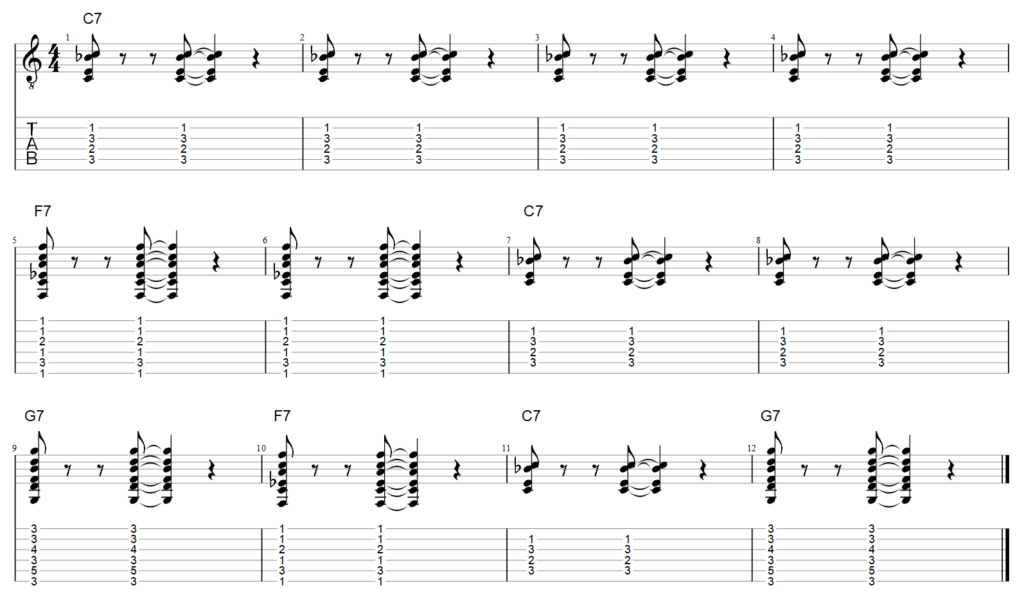
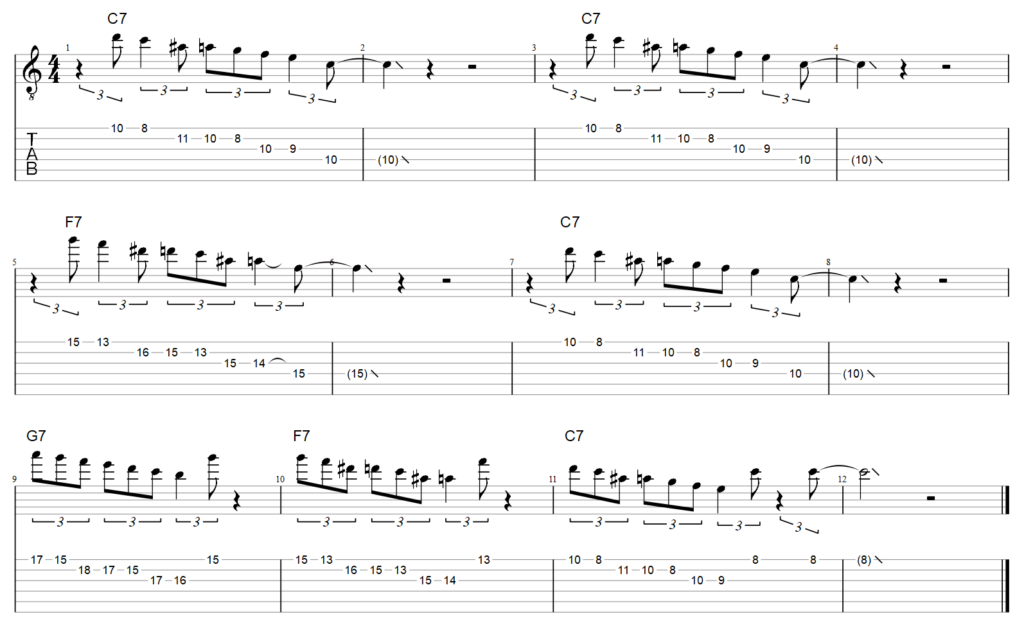
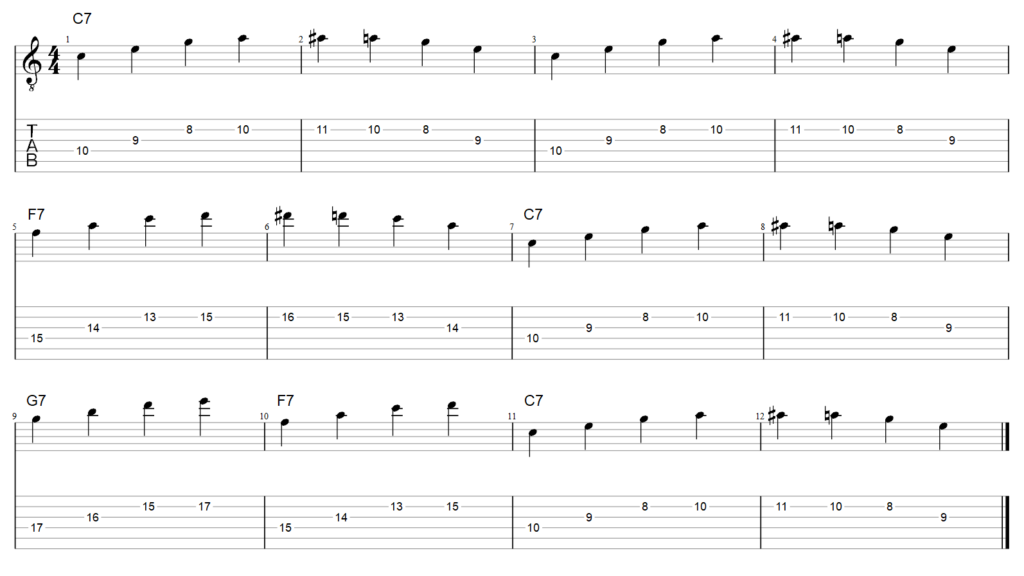

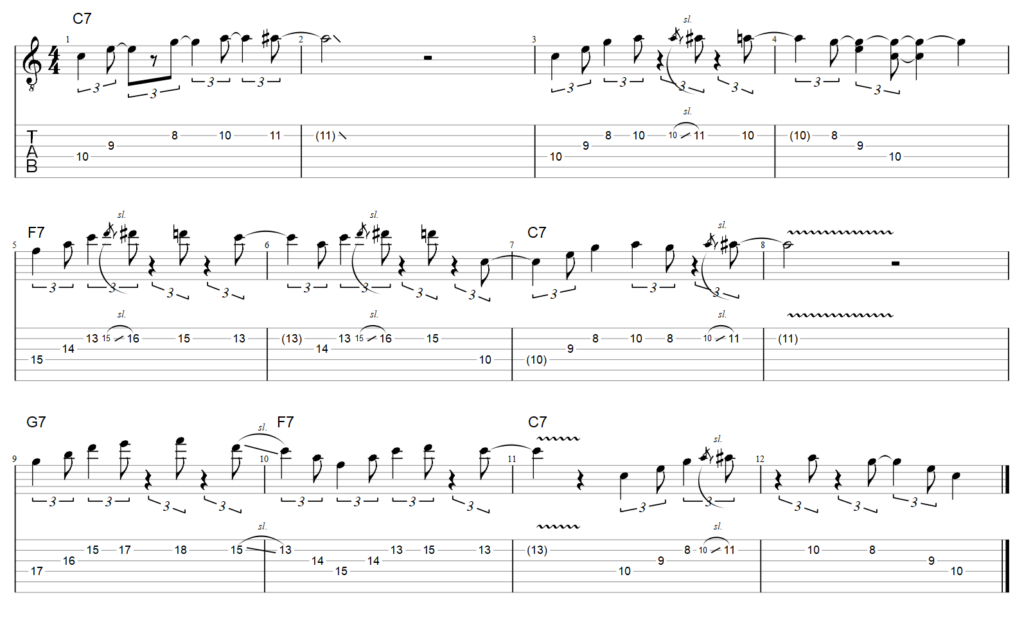
That was fantastic